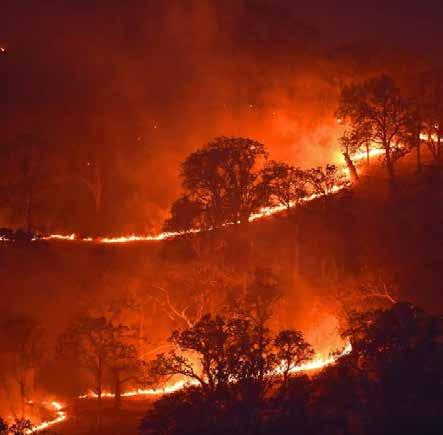
17 minute read
Newscan
MoRTH working in full capacity to better India’s highways
NEW DELHI: Since the time Nitin Gadkari took charge of the Ministry of Road Transport and Highways (MoRTH) in 2014, the Indian highways have seen a wave of development. Not only has the ministry managed to outperform all other ministries in terms of achieving targets, but has also managed to overcome massive financial losses which hit MoRTH in 2019.
Advertisement
MoRTH said in a statement that it surpassed the construction target of 2,771 kilometres (km) and has constructed 3,181 km of national highways (NH) in April-August 2020. This includes 2,104 km of highways designed by state Public Works Department (PWDs), 879 km by the National Highways Authority of India (NHAI), and 198 km by the National Highways and Infrastructure Development Corporation Limited (NHIDCL).
In addition, 3,300 km of NH work in this year have been awarded till August, which is more than twice of the 1,367km during the same time last year, the ministry said. It added that this involves 2,167 km of NH awarded
by PWDs, 793 km by NHAI, and 341 km by NHIDCL. During the April-August period, sanctions were issued for construction of 2,983 km of NH across the country, which includes 1,265 km by PWDs, 1,183 km by NHAI, and 535 km by NHIDCL. NHAI, earlier this week, had said that despite challenges faced due to the COVID-19 pandemic, it had awarded projects worth `31,000 crore in the first five months of the current fiscal year. Gadkari inaugurates 45 highway project in MP Nitin Gadkari, Minister for Road Transport & Highways, Government of India, on Tuesday, August 25, inaugurated and laid the foundation stone for 45 highway projects in Madhya Pradesh through video conferencing. According to a release by MoRTH, the road length of these projects is 1,361 kilometers and their construction costs a total of `11,427 crore. These projects will improve connectivity, convenience and economic growth in and around the state and movement of people and goods to and from neighboring states like Rajasthan, Uttar Pradesh, etc. will be eased. The better roads will save both time and fuel and also lower emission of pollutants. These projects will further decongest roads and enroute towns that will contribute to improving road experience.
On the occasion, Gadkari said that in the year 2014, the total length of national highways was barely 5,186 km, but today it is 13,248 km. He added that development works worth `1,25,000 crore are underway in Madhya Pradesh. As much as 60 to 70 per cent of the total work has been completed on approximately Rs 30,000 crore worth road works in the State. Several of these roads are important for providing connectivity to the tourist spots and backward areas of the State, he said.
NH length in Maharashtra tripled, claims Gadkari In a press communique issued by Gadkari’s office, he claimed that the length of NH in the state of Maharashtra has more than tripled in the last six years. The NH length increased from a meagre 5,700 km to 17,749 km by the end of August 2020, marking an increase of 211 per cent. The communique added that all the districts in the state are now connected with NH.
So far, NHAI and the state PWD have completed 9,281 km of roads in the state while work on 5,260 km of roads is under progress. The Government of India has spent `70,388 crore on national highways in the state so far. Gadkari also sanctioned `7,420 through Central Road Fund (CRF) on various projects. Some 166 works worth `3,820 crore have been completed. The Government of India provided `674 crore to Maharashtra under CRF in 2020-21.
California records 6 of 20 largest forest fires in state’s history
SACRAMENTO: The state of California in the United States of America has witnessed record breaking forest fires since the past couple of years. Every year, billions of dollars are lost and thousands, if not millions, of people are affected, causing loss of both property and life. This year, the California wildfires have been the biggest fires in the history of the state, worsening air quality, causing formation of massive smoke clouds and forcing 64,000 people to evacuate. The fires are also adding problems to the already widespread COVID-19 pandemic. Since the past few years, wild fires have become more and more common and severe in the state of California. In 2018, 10 large fires wreaked havoc across the state, destroying more than 500 acres of land each. Most infamous was the Camp Fire, which left 86 people dead in Paradise and caused more

than $16.5 billion in losses, according to the German insurance company Munich RE. Due to the forest fires, this August was the warmest for California and five other neighbouring American states. The intensity of these forest fires can be understood by the fact that six of the 20 largest wildfires in the history of America are currently burning in the state of California. These fires are the August Complex (the largest blaze in state history as of Thursday), the SCU Lightning Complex, the LNU Lightning Complex, the North Complex, and the Bear Complex. According to the California Department of Forestry and Fire Protection (CalFire), these are megafires that gained size and strength when smaller fires combined into unified blazes.
However, according to scientists, this is not an isolated event or caused due to unexplainable circumstances. The high rate of global warming causes arid, hot winds to blow over the entire state, drying up the trees in the large forests and making them highly susceptible to forest fires. The situation is even more serious in the case of California as the highly volatile weather is likely to bring more droughts as compared to other states and the highly concretised cities with a massive population only adds to the problem.
A paper published in 2019 in the journal Earth’s Future revealed that California’s land area burnt due to forest fires every year has increased more than fivefold since 1972. The authors of the paper attribute this in part to a warming climate.
Climate models show that as temperatures continue to rise, the atmosphere and land in some regions, like California’s forests, will grow more arid. There will be more frequent and intense droughts, followed by intense periods of rain — a form of weather whiplash. This prompts the growth of thick underbrush, which then dries out in the subsequent droughts and becomes highly flammable kindling.
A comparatively newer phenomenon that scientists are witnessing is that the wildfires grow dramatically overnight because temperatures are no more dropping at night like they used to. According to Matthew Hurteau, Associate Professor, Department of Biology, University of New Mexico, one of the main reasons for this is directly linked to human induced climate change.
Until a few years ago, as night fell and the Sun’s heat subsided, temperatures dropped and the fires considerably reduced, if not extinguished completely. This was usually when a lot of progress was made by the firefighters in completely extinguishing a forest fire as the height of the flames were shorter.
Thus, in addition to bringing peculiar phenomena to light, the California forest fires are a both a life-threatening force caused in part due to climate change, and responsible for huge financial and property loses annually.
BRIEFS | NEWSCAN
Uttarakhand govt to set up six waste to energy plants
The Government of Uttarakhand has now started working on electricity generation from solid waste in order to improve solid waste management. Madan Kaushik, Minister for Urban Development, Government of Uttarakhand, has asked government officials to draw up a comprehensive plan for the establishment of six power plants in the state that produce electricity from solid waste. The plants will be built in Roorkee, Rudrapur, Kashipur, Haldwani, Rishikesh and Kotdwar. As per the pollution control board records, it is possible to produce approximately 300 megawatts of electricity using waste generated in the state.
43% of schools worldwide lack access to water, soap: UN
The United Nation (UN) estimates that 43 per cent schools worldwide do not have access to water for basic handwashing. According to a report by the World Health Organization (WHO) and United Nations International Children’s Emergency Fund (UNICEF), more than one-third of the 818 million children worldwide who had no hand-washing facilities at their schools last year are in sub-Saharan Africa. The report states that while making the decision on opening of schools, the authorities should balance health issues along with economic and social ones and it also notes the detrimental effects of long closures of schools on children.
Delhi government launches new EV policy
NEW DELHI: The Government of Delhi has issued the Delhi Electric Vehicle Policy 2020, to boost the adoption of electric vehicles (EVs) in the national capital. The Policy has been introduced as the scheme launched by the central government was not successful in achieving its goals. The policy is valid for three years and aims to speed up the pace of EV adoption, primarily in the category of two-wheelers, public and shared transport vehicles and goods carriers. It plans to boost the adoption of battery electric vehicles (BEVs) so that they make up 25 per cent of all new vehicle registrations by the year 2024.
Financial incentives, tax and fee waivers, charging and swapping infrastructure establishment, job creation, battery cycling ecosystem and the creation of a non-lapsable ‘State EV Fund’ are all part of the new EV Policy of the Delhi government. Further, under the scheme, `30,000 would be given as purchase incentives to those buying electric two-wheelers, e-rickshaws, and goods carriers while incentives ranging between `10,000 and `1,50,000 would be given to people buying electric cars. The vehicles must

adhere to the same performance and efficiency eligibility criteria as specified in the central government’s Faster Adoption and Manufacturing of Electric Vehicles in India Phase II (FAME India Phase II) policy. The policy of the Delhi government also seeks to encourage setting up private charging points at residential and non-residential premises. The state government said it would provide a grant of 100 per cent for the purchase of charging equipment up to `6,000 per charging point for the first 30,000 charging points. An open permit will be applicable for e-autos wherein permits will be given on the first-comefirst-serve basis. The policy seeks pure electric buses to constitute at least 50 per cent of all new stage carriage buses procured for the city fleet. DUSIB to provide free education for children residing in its night shelters
NEW DELHI: The Delhi Urban Shelter Improvement Board (DUSIB) is planning to provide free education to the children of homeless staying in its shelters. The children will also be enrolled in schools later. DUSIB has 215 shelter homes across Delhi, wherein, 5,000 homeless people reside. Nearly 1,000 children aged up to eight years stay with their parents in these 32 night shelters. Since such families are usually not bothered if their children receive formal education or not, the children can be seen playing around the shelters throughout the day. Without education, these children may end living a life similar to their parents. An official of the DUSIB said that the parents will be counselled to enroll their children to study and also monitor their daily routine. This is especially important for families living in night shelters because in most families, both the parents do off jobs and spend their day out, leaving their children without supervision or guidance.“To give them a better life, we are planning to engage volunteer teachers who are ready to teach these children at the night shelters. In due course, they will also be enrolled into schools,” said DUSIB member Bipin Rai. An official said the parents will be counselled to encourage their kids to study and also to monitor their daily routine. In most of the families living in these night shelters, both the adults do odd jobs and spend their day out leaving their children without any guidance. “The classes may be started in a couple of these shelters this month itself.”
Delhi government sets target of meeting water demand-supply gap in 3 years
NEW DELHI: The Delhi Government has set a new target for itself of meeting the demand-supply gap of water in the city in the next three years. According to officials, various water augmentation projects are being expedited keeping this aim in mind. The city needs an average of 1,150 million gallons of water per day (MGD) of which, the Delhi Jal Board is only able to supply 900 MGD on an average. Thus, 22 per cent of the total demand for water in the city is not being met.
“There are several projects on which work is going on. These are expected to meet the water demand-supply deficit in the next three years,” a DJB official said. He added that the city has a total of 15 ranney wells which are capable of providing 20 MGD. However, due to the high concentration of ammonia in the water of these wells, they were rendered inoperable. Now that the Delhi Government has procured the technology to treat this water, these wells will soon become operational. The technology was pilot tested at a non-functional ranney well in east Delhi and implemented at four more such facilities. The DJB will now take up the task of operationalizing the remaining 11 ranney wells using the same technology. Apart from this, the DJB will also start work on rejuvenation of lakes across the city, which can supply upto 30 MGD water. In addition to this, Satyendra Jain, during the meeting, instructed officials to expedite the work of connecting households to the city’s sewer network. “As soon as the sewer line is laid, the DJB will provide household connections in these areas,” the official said. NGT directs installation of 175 AQ monitoring system across India
NEW DELHI: The National Green Tribunal (NGT) has directed installation of 175 air quality monitoring stations across the country within the next six months. NGT directed the Central Pollution Control Board (CPCB) to monitor the work by holding periodical online meetings with the Chairman/ Member Secretaries of state pollution control boards (PCBs) and other relevant authorities. The order by the NGT added that the funds available under the ‘consent mechanism’/’environmental compensation’ be used for the purpose of construction of these monitoring centres and that the construction work must begin within one month.

A bench headed by Justice Adarsh Kumar Goel, Chairperson, NGT, said that it will be preferable if 25 of the total 175 air quality monitoring systems are set up by CPCB/State PCBs/Pollution Control Councils (PCCs) jointly (with CPCB financing out of its environmental compensation funds).
The Tribunal passed the orders after CPCB submitted a report that 173 stations have already been set up. NGT also directed that Carrying Capacity and Source Apportionment studies may be simultaneously undertaken by the state PCBs. “Work in this regard may commence within one month and completed in six months. State PCBs/ PCCs will be at liberty to either undertake the study in-house or by hiring any other agencies,” the bench said. The tribunal also directs authorities to take steps prohibiting/shifting polluting activities which are found unsustainable to other locations, in interest of public health and protecting the environment.
PUC certificate mandatory to renew vehicle insurance: IRDAI
The Insurance Regulatory and Development Authority (IRDAI) has notified the insurance providers in India with a new circular, asking them to obtain a valid pollution under control certificate(PUC) for the vehicle while renewing the policy. The regulatory body has said that the insurance company will not pay any damages if the vehicle’s PUC’s validity expired during the time of the accident, adding that the pollution license is essential for all claims. The Supreme Court of India had previously ordered insurance companies not to ensure unless they have received a valid PUC certificate on the date of insurance policy renewal.
Plasma therapy for COVID-19 treatment still experimental: WHO
The World Health Organization (WHO) said that the use of plasma from patients who have recovered from COVID-19 to treat patients with COVID-19 is still considered as “experimental” therapy and preliminary findings showing that it may work are still “inconclusive”. On Sunday, August 23, emergency authorization of convalescent plasma for COVID-19 patients was approved by Donald Trump, President, United States of America (USA). Dr Soumya Swaminathan, Chief Scientist, WHO, said that multiple inflammatory diseases have been treated over the centuries using convalescent plasma therapy with varying levels of success.
BRIEFS | NEWSCAN
India’s longest ropeway inaugurated in Guwahati
The longest river ropeway in India, with a length of 1.82 km, connecting Guwahati and North Guwahati over the Brahmaputra River in Assam, was inaugurated on Monday, August 24. It is expected to increase tourism in the region. The ropeway will cross Urvashi Island and the travellers will catch a glimpse of the Umananda Temple on Peacock Island, established by Ahom King Gadadhar Singha. The Guwahati Metropolitan Development Authority (GMDA), which has been responsible for the execution of the project, said that the ropeway comprises two cabins with a capacity of 32 passengers each but as per COVID-19 protocol, will carry only 15 people for the time being.
Kerala tops childcare survey
A report compiled by a nongovernmental organisation Mobile Creches, has placed Kerala, Mizoram, Goa, Tamil Nadu and Tripura as the states with best services to ensure wellbeing of children. The report was launched by M Venkaiah Naidu, Vice-President of India. The Young Child Outcomes Index measures health, nutrition and cognitive growth with the help of indicators such as Infant Mortality Rate (IMF), Stunting and Net Attendance at the primary school level. It identified eight states that have scores below the country’s average namely Meghalaya, Assam, Rajasthan, Madhya Pradesh, Chhattisgarh, Jharkhand, Uttar Pradesh and Bihar.
NEW YORK: United Nations Children’s Fund (UNICEF), on September 3, said that 28 drug manufacturers in 10 countries can produce unprecedented amounts of COVID-19 vaccine over the next two years to fight the ongoing pandemic. The United Nations agency announced that it would assist in procurement and distribution of COVID-19 vaccines globally.
The role of UNICEF is part of the COVID-19 vaccine allocation plan, called COVAX, which is co-led by the World Health Organization (WHO), and is aimed at buying and providing equal access to COVID-19 shots. Till date, 76 countries have committed to join the COVAX initiative. UNICEF reported that 28 manufacturers of COVID-19 vaccines had shared their annual production plans through 2023. A market assessment by UNICEF indicated that manufacturers are willing to produce unprecedented amounts of vaccines collectively over the next 1-2 years. However, the drug makers have stated that the projections are largely dependent upon other factors including the success of clinical trials, advance procurement agreements being put in place, confirmation of funding and streamlining of regulatory and registration processes.
The new role of UNICEF with COVAX originates from its identity as the largest single vaccine buyer in the world. The UN agency reported that it purchases more than 2 billion doses of vaccines on an annual basis for routine immunization and outbreak response on behalf of almost 100 countries. The studies related to COVID-19 are being done on a regular basis and the results show varied impacts of the virus.

Palaniswami announces multiple development projects in Nagapattinam
NAGAPATTINAM: Edappadi K Palaniswami, Chief Minister, Tamil Nadu, has announced that a mega food processing park will be set up at Nagapattinam at a cost of `1,000 crore. The announcement was made by Palaniswami while addressing a gathering at the Collectorate after reviewing measures taken to combat the coronavirus pandemic. He said that the state is making major investments in agriculture and healthcare despite the pandemic. “All agricultural activities are now going on without any disruption,” he said. About 28 lakh tonnes of paddy has been procured from the farmers in Cauvery delta districts amid the pandemic, which is a historic achievement, he said, adding that it is five lakh tonnes more as compared to the last year. He pointed out that desilting work is meticulously being carried out in delta districts ensuring the free flow of Cauvery water to all tail-end areas. Palaniswami said that government hospitals in the state are providing better service than private hospitals. “Infrastructure facilities have been improved to a great extent. Poor people now get easy access to high-quality healthcare in the state,” he said and added that a new medical college with a modern hospital is being constructed at Nagapattinam at a cost of `365 crore.
Talking about the mega food processing plant, Panaliswami said that it will also contribute largely in employment generation. In higher education enrolment too, Tamil Nadu has made significant improvements during the past 9 years. Claiming that the government had taken all steps to combat COVID-19 and control its spread, the chief minister pointed out that Tamil Nadu has the highest recovery rate in the country and is conducting more COVID tests per day than any other state.










